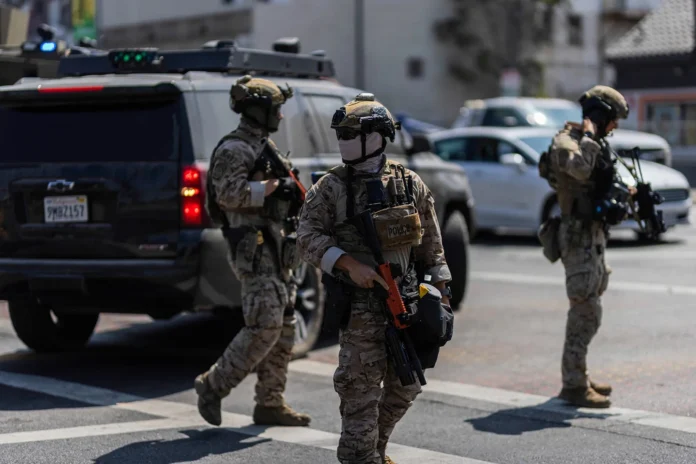In a consequential decision that could reshape the landscape of immigration enforcement in California and beyond, the U.S. Supreme Court on Monday permitted Immigration and Customs Enforcement (ICE) agents to resume “roving patrols” in Los Angeles, siding with the Trump administration in a bitterly contested legal battle.
The 6–3 ruling overturned a lower-court injunction that had limited ICE operations, clearing the way for federal agents to conduct broad street-level stops and sweeps across Los Angeles County. Supporters of the decision argue it strengthens border security and restores federal authority, while critics warn it opens the door to widespread racial profiling and civil rights violations.
The Ruling: A Divided Bench
The Court’s conservative majority voted to lift the restrictions imposed by the Ninth Circuit Court of Appeals. Writing for the majority, Justice Brett Kavanaugh emphasized that ICE officers must still meet a “totality of circumstances” test when initiating stops but rejected the lower court’s view that ethnicity, language, or occupation could not play a role.
Kavanaugh wrote:
“While race or language alone cannot constitute reasonable suspicion, those factors may contribute to the analysis when viewed alongside other contextual indicators of immigration violations.”
The decision effectively broadens ICE’s operational authority, granting agents wide discretion in determining whom to stop.
In dissent, Justice Sonia Sotomayor, joined by Justices Elena Kagan and Ketanji Brown Jackson, condemned the ruling as a “constitutional backslide.” Sotomayor accused the majority of authorizing “de facto racial profiling under the guise of reasonable suspicion,” and criticized the Court for once again relying on its “shadow docket” to make a decision with sweeping civil rights implications.
What Are “Roving Patrols”?
The patrols in question allow ICE agents to stop individuals in public spaces—streets, workplaces, or transit hubs—based on suspicion of immigration violations. Unlike traditional enforcement, these patrols do not require warrants or prior approval, raising longstanding concerns over Fourth Amendment protections against unreasonable searches and seizures.
Civil rights groups note that earlier versions of roving patrols in Southern California during the 1980s and 1990s often resulted in the detention of lawful residents and even U.S. citizens of Latino heritage.
Political and Community Reactions
President Donald Trump hailed the ruling as a “historic victory for law and order,” saying it would help dismantle so-called sanctuary city policies in Los Angeles and ensure “immigration laws are enforced without apology.”
California Gov. Gavin Newsom, by contrast, denounced the decision, calling it “a racially motivated assault on immigrant communities.” He pledged state-level resistance, vowing that California “will not stand by as our residents—citizens or not—are targeted on the basis of appearance or language.”
Los Angeles Mayor Karen Bass warned of “heightened fear and division” in the city, cautioning that the patrols could undermine trust between immigrant communities and local law enforcement.
Legal Fallout and Next Steps
The case is far from over. The underlying lawsuit, brought by the American Civil Liberties Union (ACLU) and several Los Angeles residents, remains active in the Ninth Circuit. A full hearing is scheduled for September 24, where judges will weigh the constitutionality of the patrols in greater detail.
Advocacy groups argue the Supreme Court’s intervention signals a troubling precedent: federal immigration authorities can use ethnicity, language, or neighborhood demographics as part of their enforcement calculus.
“The Court has essentially given ICE a green light to racially profile,” said Ahilan Arulanantham, counsel for the ACLU of Southern California. “Latino and immigrant families in Los Angeles now face the daily risk of arbitrary stops, even when they have lawful status.”
Implications for Law Enforcement and Civil Rights
The ruling is expected to have immediate effects in Los Angeles, home to one of the largest immigrant populations in the United States. Advocates warn that roving patrols could discourage crime reporting, reduce cooperation with police, and further marginalize vulnerable communities.
Legal scholars also note the broader constitutional stakes. By loosening the standards for “reasonable suspicion,” the Court’s majority may have redefined the balance between individual liberty and government power in ways that could reverberate across multiple areas of law enforcement.
At the same time, the Trump administration views the ruling as a mandate to expand similar patrols in other urban centers. DHS officials have already indicated plans to redeploy additional agents to California, Arizona, and Texas.
Bottom Line
The Supreme Court’s ruling on ICE roving patrols has escalated the clash between federal immigration enforcement and state-level protections in California. While the Trump administration celebrates the decision as a restoration of authority, immigrant communities and civil rights advocates see it as a rollback of fundamental liberties.
As the Ninth Circuit prepares for a full hearing later this month, the debate over immigration enforcement—and the line between security and profiling—appears set to intensify.




